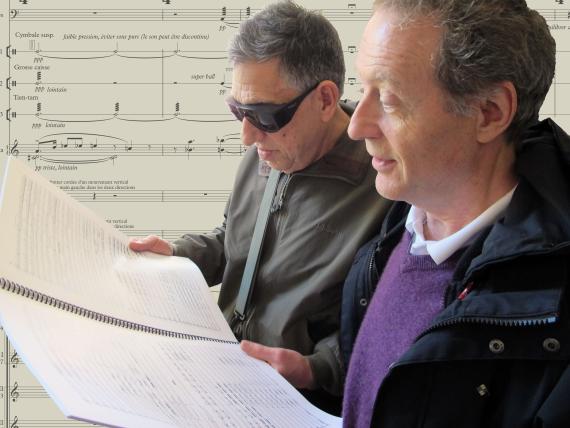A new work by UW Composition professor Joël-François Durand, Tropes de : Bussy, for orchestra, commissioned by Seattle Symphony and Music director Ludovic Morlot, receives its world premiere on Friday, April 18 at Benaroya Hall, with a second performance on April 20. Retired UW professor Larry Starr delivers pre-concert talks on both evenings. The colleagues met recently at the School of Music for a conversation about the new work and other topics.
Larry Starr: Let me start with the title: Tropes. What does that mean to you as a composer, and what should the listeners know about what it means?
J.F. Durand: Well, the full title is Tropes de : Bussy. So let me address first the second part of the title, de : Bussy. It is of course a little transformation of the name of the French composer Claude Debussy and refers to the fact that I used music from some of his piano Préludes as basic material for my piece. But since his music isn’t really very much present – it’s hidden most of the time – I modified his name a little bit to reflect his absence, the distance I took from his original texts.
Now on to Tropes: the original meaning of the word comes from the Medieval times, when composers (and poets) would take an original text and then write their own music (text) to comment around it. Then we have the more modern usage of this term, which refers to the idiosyncratic aspects of a text, the typical “gestures” or turns of phrase a writer displays.
Both meanings are relevant to my piece. On one hand, Debussy’s music is always present inside Tropes, but most of the times it is so transformed that one could say that I am commenting on it, adding – or subtracting, deforming, playing with some of its elements. Then, on the other hand, I sometimes focus on very specific aspects of Debussy’s music and the result becomes a sort of analytical reading of his late music.
For example, in the second movement of Tropes, I make much use of a rhythmic figure that is very visible in the “la danse de Puck” Prélude. It’s based on the dotted-eighth-sixteen-note pattern, that jumpy, dance-like rhythm that is heard right at the beginning of the Prélude, in the main theme, and is also found a lot in his late music (for example, in the first movement of the Images for orchestra, Gigues). I play with this pattern for long stretches of the movement, and it is also used at times as a kind of “melodic modulation” to branch out momentarily into other of Debussy’s works of that period that make use of a similar rhythmic pattern. So I isolate this pattern as something that is somehow idiosyncratic to Debussy’s music at the time, regarding it as a trope in his language. And this applies to other domains as well, such as his choice of certain scales, or some of his orchestration techniques. In that sense, my work on the Préludes became a little bit of an analysis of Debussy’s ways, of some of his typical musical ideas from that time.
LS: You’re almost allowing Debussy’s works to talk to each other.
JFD: Exactly. So in that sense, the quotations I just mentioned, as “deviations” from the original Préludes, are used in an almost analytical fashion: if I find something in a passage of a Prélude that sounds very close to something that he says somewhere else, I allow the excerpt from the other piece to show up fleetingly in the middle of the first one, and then it disappears again. These inserts are like snapshots into another landscape. I let the music become a commentary of itself.
But I occasionally also opened the door to other such deviations of the main music, when it seemed fitting. One prominent example is Debussy’s love for the interval of open fifths, which are often stacked up in groups. We hear that prominently in his opera Pelléas et Mélisande; it’s there right at the beginning of the work. Accordingly, I decided to give that sound a special role, and it appears also close to the beginning of Tropes, although it’s not a quotation, it’s integrated in the texture and presented in an extremely slow tempo.
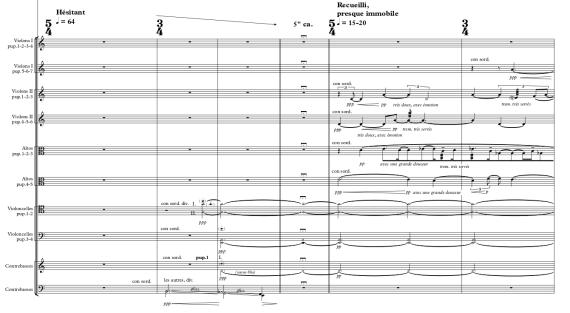
Now, there’s another composer close to Debussy’s time who makes use of these open fifths to achieve a fairly similar, mysterious effect: it’s Berg in Lulu. Here the open fifths are usually associated with a specific character, the Countess Geschwitz, and there’s a wonderful passage in Act III when she appears on stage, accompanied by a sequence of fifths that quickly becomes distorted.
Again, as I did for the melodic modulations I was just talking about, I created a connection between these sources, almost as if Mélisande (whose “theme” is heard furtively in the first movement of Tropes) was conversing with Lulu across time. But the sound of the fifths comes back in other parts of my piece, predominantly in the last Trope where it serves as transition between sections.
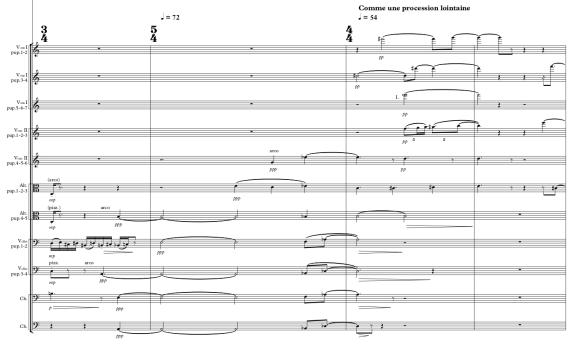
LS: Why Debussy? Is he a composer you’ve related to for a long time or does it have to do basically with the interest for this particular piece?
JFD: No, actually, I had a very ambiguous relation with Debussy for a long time. I used to like the early music, La mer in particular, a long time ago, and some of the Préludes – I was forced to learn a few of them when I was studying the piano, you see! I thought they were lovely, but on the whole a bit too sentimental (a number of those from the first Book, anyway). But that was about the only works I felt some affinity with. Then, two years ago (in early 2017) I was teaching this orchestration class, and I gave as a final project for the students an arrangement of one of the Préludes. I made an arrangement myself as well in order to go through it and see what kinds of difficulties the students would encounter in their own work.
LS: Which Prélude was that?
JFD: “des pas sur la neige,” the 6th of the first Book. The assignment for the students was for ten instruments, so that’s what I used at first. Then, after the term was over, I started to have these images of an arrangement for a large orchestra, so I did a couple of versions of this same Prélude for orchestra, to try different colors.
To my surprise, it was turning into quite an exciting project, so I did another Prélude, again first to the ten-instrument combination, in order to set the basic colors in place, followed by a version for orchestra. Then I did a third one, with the same process, first for the small group, then the full orchestra. So the whole thing grew progressively, naturally, out of that interest, that initial challenge.
While doing this, I started to look seriously into Debussy’s late orchestral music, to understand how he chose his colors, organized his textures, and so on. That’s when I got really involved in his music; I was just very curious to understand. It wasn’t a decision to suddenly start studying Debussy, or a sudden revelation that I loved his music; it just grew out of this orchestration project, and I discovered a lot of things that I didn’t really know about the music that were absolutely fascinating.
LS: Well, that’s the most natural way for something like that to develop.
JFD: Yes, it wasn’t forced in any way. As I was reworking the arrangements again and again, I progressively started to change the music, adding to it (the trope idea we mentioned earlier), changing the order of sections or phrases, and so on. This, too, was a way to understand the music from the inside, to see how it resisted changes.
Then, a couple of months later, Ludovic Morlot casually asked me what I was working on, and I mentioned these orchestrations. He pointed out that the Debussy anniversary year was coming up (2018) and said he’d like to see the work when I was ready to show it. Over the summer I worked more on them and sent him three of the orchestrations. We met a little later, and he said, “You know, I’d like to program something along those lines, but not the orchestrations themselves; rather, something that is more your voice, with the Debussy as basis.”
So that’s when things got really interesting, and actually, much more difficult! As I just said, I was already in the process of messing a bit with the original text, but at that point it was still mostly Debussy’s music. The next step, to integrate the music and completely transform it, meant that I had to distance myself much more than I had so far. In essence, I had to force myself to first forget the original texts and then bring them back metamorphosed. It took a lot of failed attempts to get there because I didn’t want to use completely arbitrary procedures to eliminate the originals – I wanted to keep some of the “perfumes” – but I had to find how to detach myself from the Préludes, to invent something completely different.
LS: Should a listener approaching this look for any kind of stylistic influence from Debussy? I know there are occasional quotations, but they certainly don’t dominate the piece.
JFD: No, my idea was to have these allusions, sometimes atmospheric, sometimes more specific, to Debussy’s music, but rarely clearly on the surface. My piece is based on Debussy’s music, everywhere, but it is often so transformed that you barely hear it, if at all. And then, suddenly a passage from the original piece itself shows up a little bit and disappears again or recedes to the background. And, as I was saying earlier, sometimes these allusions trigger memories from other works (the snapshots), as the kind of associations that occur in dreams, when sometimes images come up without you expecting them, but you realize that they are related somehow even though they belong to completely different situations. That’s the way quotations often come up in my piece. For example, there’s one in the second movement that is there because I realized that in the Puck Prélude, there’s a measure that is very close to a measure in Jeux: the main theme of Puck is transformed (in fact, it’s compressed and has become more chromatic) and it’s suddenly almost the same melodic line as in a passage from Jeux. So that measure from Puck is allowed to come out to the surface, to be clearly audible, and then immediately it branches out into the excerpt from Jeux. And it disappears again. And then the same little melody becomes, for a short moment, an old traditional French song (another of Debussy’s favorite tricks, incidentally).
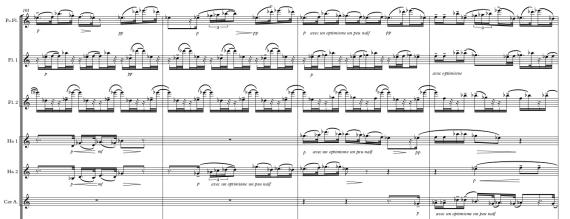
This is the kind of association that I was just talking about as a dream association. Things show up, you don’t really know why, but there is a link. Having said that, the first and second movement follow pretty closely the chronology of the corresponding Préludes. In the first movement, for example, the moment where the excerpt from “les sons et les parfums tournent dans l’air du soir” appears is about at the same place as it does in the piano piece (It’s the main theme, but it’s in a new key in the piano Prélude). Soon afterwards there are short, dramatic, descending gestures in the orchestra that are, in fact, amplification of similar descending gestures in the piano version. A little later on, the piano Prélude has wave-like patterns (“Tranquille et flottant”) repeated three times, and you can somehow hear them in the orchestra, but there are extremely slowed-down and thickened by close harmonies. So, as you see, you can sometimes follow certain aspects of the original, and sometimes they are modified in such a way that it’s much harder to relate them, but all along, the original music is running under the surface, in the background, whether it’s audible or not.
LS: You, of course, have the most intimate knowledge of these pieces. How would you advise a listener coming into this without that level of intimate knowledge?
JFD: You don’t necessarily need that level of knowledge. What will happen is that, as you know, Debussy’s music is relatively tonal, relatively consonant – at any rate, compared to the music I wrote…
LS: … Ok, I’m glad you qualified that because the interesting thing to me about Debussy’s music is how actually dissonant it can be, but it doesn’t sound that way because of the way he voices his chords.
JFD: Yes, and that’s one fascinating thing about his late works. They’re full of strong dissonances, but you don’t hear them as you would in atonal music; it’s rarely clearly tonal either. And, of course, in terms of tonal functionality, Debussy completely and fundamentally altered the way music was written until then. So, when you listen to Tropes de : Bussy, what you’ll hear is, in general, a decidedly non-tonal language that occasionally shifts toward somewhat more tonal when it moves a little bit closer to Debussy’s harmonic language because it sounds then less dissonant. That should be fairly audible. In that sense, this weaving in and out of relative consonance and dissonance is very close to the principle of Debussy’s shifting colors, except that I don’t shift between various levels of tonal allusions, I shift between degrees of consonance and dissonance.
LS: Some of Debussy’s influence here seems to me more conceptual than specific. For example, you were trying to get at the same feeling as Debussy had, say, in “des pas sur la neige” to get to the concept of the piece, rather than imitate the piece, literally.
JFD: That's right, the original impetus was to go through the emotional response in order to get to the conceptual dimension. What I mean by that is that I tried to extract the affective essence, if you like, of each of the Préludes I’m using. For example, in “des pas sur la neige,” the original is not overly dissonant, but it’s clearly a climate of desolation, of loneliness.
LS: Oh yes. I’ve tried to play these pieces. To me, “des pas sur la neige” is one of the loneliest, most desolate pieces I know.
JFD: Yes, I tried to take hold of that climate and to translate it into another context, a more modern one, a hundred years later. In fact, there was this image that guided me all along: the image of making a translation of the original text into another language. Orchestration itself is already a form of translation. Indeed, what do you do when you do a text translation? You can’t do it word by word because it probably won’t get to the spirit of the original. You have to extract the rhetoric, the affective content, as well as well as the conceptual and bring it into another, completely different environment. But when you realize an orchestration you have to decide whether you’re going to try to sound like what the composer might have done, replicate as closely as possible their sound-world – a good approach for the classroom, but of little interest otherwise (also a necessary first step to anything else, by the way) - or you can decide to bring the original into your own time and use colors that speak more readily to that time (think Shakespeare translated into old or into modern French). In that case, you have to make sure that you still maintain the essential ties to the meaning of the original, that you don’t damage the rhetoric, the affective content as well as the ideas themselves.
Finally, the next step to displace the original to the time you’re working in would be to rewrite it so that its deepest meaning is maintained while the stylistic layers are modified into your own creative world. This is not an orchestration, anymore, of course, it’s a retelling, a creative translation. That’s what I was trying to do here: keep the essence of the character, the atmosphere of the original, but push it in a different direction. This has to do with colors, such as harmonic and instrumental colors of course, but it also brings us back to the idea of trope, the archetypal gesture, so to speak, that conveys that sensation, as well as the commentary around it to highlight it better. I actually went through these three steps myself during the two years of composing the piece. But the only interesting one for me is the last step, the end result of this research into the affective essence of the original texts.
LS: That’s very illuminating to me, and I’ll bring this out in my pre-concert talks because I think a lot of people misconceive contemporary music as highly intellectual and you’re trying to get at something that is very emotive.
JFD: Exactly. But it’s clear that the intellectual dimension is just as present, it has to be integrated all the time. It comes into play here to support the emotional one. For example, in the “des pas sur la neige” Prélude, Debussy constantly reworks the harmonies associated with the initial motif, enriching it as well with melodic lines. This idea carries into the third movement of my piece, where each section is grounded on one of the notes of the initial motif (D-E-F; then in my piece, followed by G-Ab), and I color each of these notes with different and fluctuating harmonic and timbral clothing. This mirrors Debussy’s constant reworking of the colors in his Prélude.
Another, perhaps more significant example of this is at the formal level. Debussy’s forms are extremely challenging to perceive, particularly in the late works. Often the music seems to flow from one idea to the next, and it’s challenging to follow the continuity of the ideas and their relationships over long periods of time. That’s another aspect of his thinking that I was particularly interested in while writing Tropes.
LS: One might ask why you chose these particular piano Préludes. Do you want to say anything about the ones you particularly chose?
JFD: It’s a funny story: I chose “des pas sur la neige” originally because it was probably the relatively less complicated one for the students to arrange; the textures are not too complex, and there’s a good amount of color changes (through harmonic variations) to play with. But of course it’s not easy at all! The other Prélude I chose next: “le vent dans la plaine,” to be placed before “des pas sur la neige,” and “Minstrels” to go after it, were pretty much decided on a whim. It felt that they were going well together. But the funny thing is that a few months later, I discovered that the ones I had selected had been chosen by Debussy himself for a recital where he premiered them in 1911, in that same order!
LS: Oh, you didn’t know that?
JFD: No, not when I chose them.
LS: It must have been a wonderful discovery!
JFD: Indeed, I thought that was amazing. Debussy himself never played the whole set of twelve together (nor did he recommend that it be done, by the way). He gave a few recitals where he usually premiered four or five from Book One or Two, mixing from the two Books occasionally. But in that particular recital, he actually started the set with “les sons et les parfums tournent dans l’air du soir” followed by the three I just mentioned. So I immediately decided to add that first one as well, to start my set, although I had at one point already considered it, too, but had rejected it because I couldn’t find the right way to orchestrate it. The coincidence was too good to pass! But I was finally able to tackle it once I had decided to go beyond straight orchestrations and approach it from a completely different angle; it could then become my first Trope.
LS: But you have five, actually.
JFD: Yes, I added “la danse de Puck” because I very much wanted to do it as well. At first, I considered arranging it as a separate movement, but I soon realized that it would work better paired with “le vent dans la plaine” and the combination of the two became my second movement.
LS: In some ways, the juxtaposition of “des pas sur la neige” and “Minstrels” is kind of shocking.
JFD: Yes. But “Minstrels” is shocking…
LS: … all by itself…
JFD: Yes, with all these constant shifting of directions, interruptions and so on. But that’s not uncommon in Debussy’s music.
LS: Do you want to call attention to some of the unusual, specific aspects of your piece? Obviously the most prominent one is playing the recording of Debussy himself playing “Minstrels.”
JFD: There is a recording that Debussy did in 1912 on this sort of mechanical piano, the Welte-Mignon—which was really a complex mechanism added onto a normal piano that could record pitches, rhythms and dynamics. It was a bit different from the roller piano – it could also record dynamics – but the “recording” was also done on a kind of roll. The roll has been conserved, so it’s possible to rebuild the original mechanism, attach it to a modern piano and play it that way, as if the pianist was playing on any modern instrument. That’s what was done first by Kenneth Caswell of the Pierian Recording Society, and they put the CD out for commercial release. After hearing it, I got in touch with the company and the current manager was delighted to hear that the recording was going to be used for that purpose. My idea of putting small excerpts from this recording in my piece (in the last movement) originated because in “Minstrels” Debussy clearly alluded to another type of mechanical instrument that was quite popular at the time: the barrel organ (mm.28-31 in the Prélude).
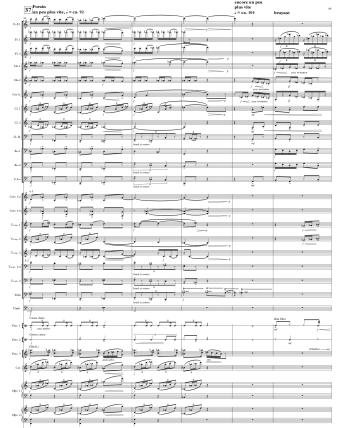
LS: It does sound like some kind of popular air.
JFD: Exactly, and it’s interesting because the barrel organ was very common in those days, you could readily hear them in the streets. And indeed, we find that instrument imitated even more clearly in other works written around the same time, notably in Stravinsky’s Petruchka and Berg’s Lulu. So it’s clear that these instruments of mechanical reproduction exerted some fascination for composers then, in large part because it represented a sound source that coincided with specific scenic needs (as in Petruchka and Lulu), but very likely also because the idea of being able to reproduce music by mechanical means was still a relatively new thing (and that’s also the time when the phonograph started to appear!). Debussy expressed his amazement in a letter to the Welte-Mignon manufacturer in 1913 after hearing his “recordings.”
In “Minstrels” we can also see a parallel with the idea of mechanical construction in the way Debussy juxtaposes little bits of phrases with each other, how they seem isolated from each other. It’s a fairly typical aspect of his writing, but it’s particularly touching in “Minstrels” because here he evokes the idea of mechanistic construction in the layout of the various tunes and in the direct sound allusion of the barrel organ.
I wanted to work from those two mental images in my last movement so I stayed closer to the original text than in the other movements and this led me to apply different techniques to transform this particular Prélude. Here I applied deformations to the melodic fragments of the original text so that we hear some kind of dysfunctional reproduction machine that sometimes slows down, or accelerates, or skips, gets stuck on a few bars, etc. In this way, the idea of the mechanical reproduction infuses the whole movement both in sound – with some fragmented quotes from Petruchka and Lulu integrated in the textures, as well as an arrangement of the four bars of the Prélude that I mentioned earlier, now arranged for an enormous, breaking-down barrel organ – and in the presentation of the phrases.
And finally, I thought that bringing in – through our modern technology of reproduction – Debussy himself playing the old mechanical reproduction machine that he used 100 years ago was quite fitting in that context. In fact, I won’t ruin the surprise, but you’ll have to wait until the concert to hear exactly what I did with that recording at the end. It adds another layer of meaning to this whole gallery of technological mirrors…
Now, remember that it’s the last movement of Tropes de : Bussy: Debussy has been present as a ghost through his music since the beginning, in fleeting images; but in the last movement, he is allowed to appear, like an actor finally playing himself in the last scene.
LS: It’s a nice image, Debussy as a ghost.
JFD: Yes, his physical presence finally emerges among us.
More information about Seattle Symphony's April 18 and April 20 performances may be found here.
